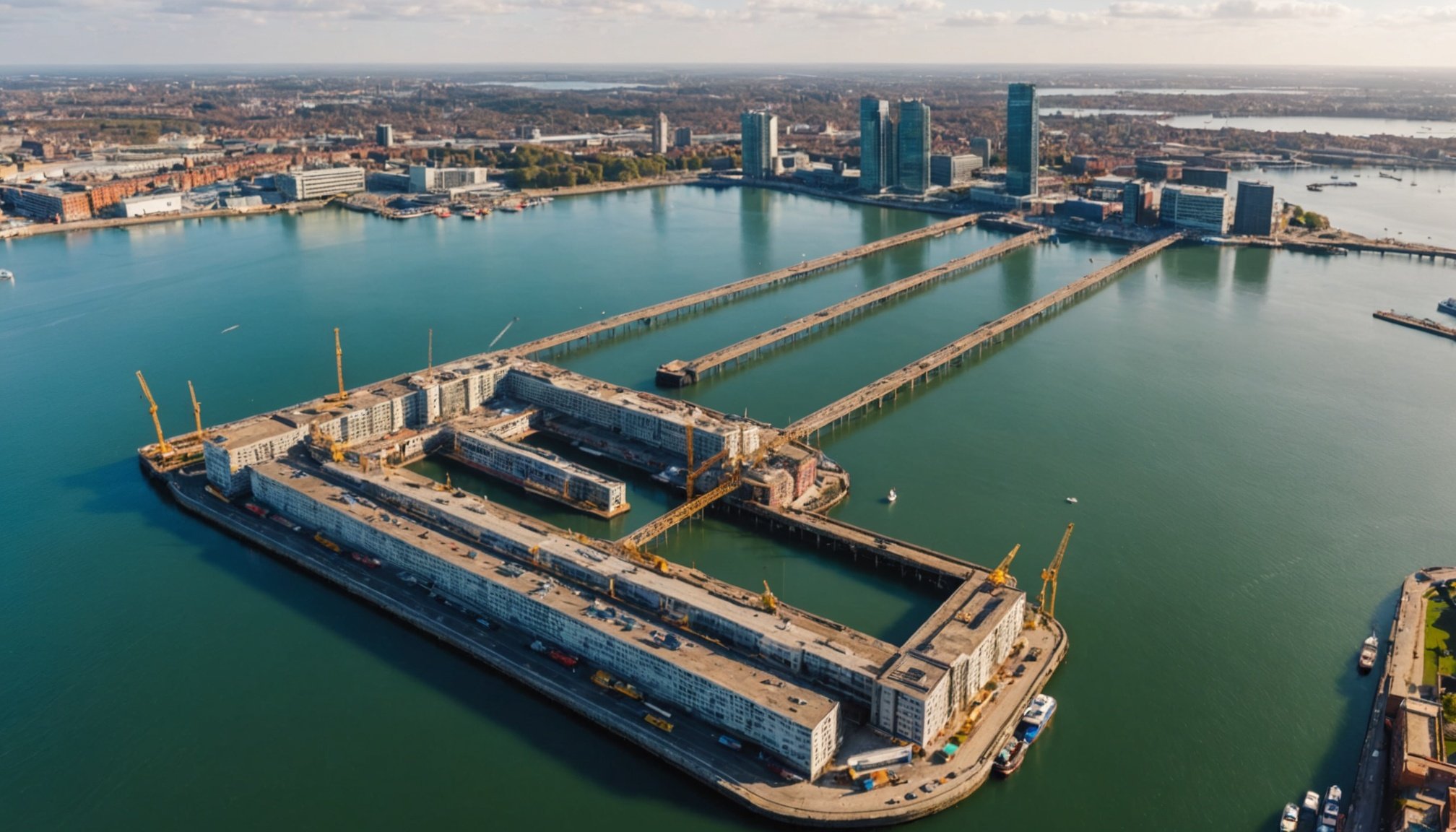Overview of Construction Loans for Waterfront Properties
Construction loans are a key financial resource for building on waterfront properties, facilitating specific stages of development. These loans differ from traditional mortgages, focusing on funding the actual construction and initial costs. Once the project is completed, construction loans are typically refinanced into a standard mortgage. The uniqueness of waterfront properties necessitates tailored loan structures, considering the distinct challenges and opportunities they present.
Securing financing for waterfront properties often involves additional considerations due to potential environmental impacts and local zoning regulations. Given their natural appeal and desirable locations, waterfront properties face stricter environmental controls, which can complicate the loan approval process. It’s essential to navigate these regulations to not only secure funding but also to ensure the project complies with all necessary legal requirements.
Also read : Essential Legal Guidelines for Evicting Tenants from UK Commercial Properties
Understanding UK regulations is crucial when dealing with construction loans for waterfront properties. UK’s regulatory framework outlines specific guidelines and standards to protect waterfront areas. Therefore, borrowers must familiarize themselves with these regulations to avoid any compliance issues. Partnering with knowledgeable advisors can help mitigate potential roadblocks, ensuring the project’s financial and regulatory success.
This comprehensive approach to understanding construction loans and the unique aspects of waterfront property financing is vital for successful development.
Also to read : Exploring the Effects of Nottingham”s Local Council Rules on Home Extensions and Mortgage Options
Key Influencers in the Loan Process
Navigating the complex landscape of construction loans for waterfront properties is often aided by influential lenders, dedicated brokers, and seasoned market advisors.
Major Lenders in the UK
Prominent banks and financial institutions play a significant role in funding waterfront developments. These lenders are critical due to their substantial resources and expertise in handling the unique aspects of these projects. Specialized lenders focus exclusively on waterfront properties, offering tailored loan packages that align with the distinctive challenges of these locations.
Role of Brokers
Brokers act as intermediaries, simplifying the loan process by connecting borrowers with lenders best suited to meet their needs. Utilizing a broker can enhance the likelihood of securing favorable terms, as they possess in-depth market knowledge and strong relationships with financial institutions.
Market Advisors and Consultants
Receiving expert advice from market advisors is invaluable for borrowers attempting to secure financing for waterfront properties. These advisors provide insights into market trends, regulatory changes, and potential risks. An illustrative case study showcases a successful waterfront financing where collaboration with experienced advisers resulted in a seamless loan approval process, highlighting the importance of their role in securing the right funding.
Regulatory Bodies and Their Impact
Understanding the role of regulatory authorities is fundamental when navigating construction loans for waterfront properties. In the UK, several key regulatory bodies oversee loan regulations to ensure compliance and protect environmentally sensitive areas. These institutions set standards that govern the development process, ensuring that projects meet environmental, social, and structural requirements.
Recent regulations have introduced more stringent measures specifically targeting waterfront property financing. These changes aim to minimise ecological disruption while promoting sustainable development practices. For borrowers, this means additional hoops to jump through, but these are crucial for maintaining ecological balance and legal compliance.
Staying informed and ensuring compliance throughout the loan process is not just a legal requirement but a strategic priority. Any oversight can lead to significant delays or, worse, the rejection of the loan application. Engaging with consultants who are well-versed in these regulations can provide invaluable guidance, facilitating a smoother loan process.
Being proactive about understanding these regulatory landscapes can result in a more predictable and successful financing journey. Borrowers with a keen awareness of regulations and who foster relations with regulatory bodies can navigate the complex landscape of construction loans with greater ease and confidence.
Current Market Trends Affecting Loans
Staying informed about market trends is crucial for borrowers seeking construction loans for waterfront properties. Interest rates significantly impact loan accessibility and affordability. In recent times, the UK has seen fluctuations in interest rates, which can alter the cost of borrowing. A lower interest rate environment can lead to more favourable loan terms, whereas rising rates may increase overall costs.
Property values for waterfront areas showcase unique trends. Typically, these properties maintain high value due to their desirable locations. However, factors like climate change and environmental legislation can affect prices. Understanding these trends is vital for borrowers to make informed decisions and anticipate potential financial implications.
Additionally, broader economic influences, such as GDP growth, unemployment rates, and market stability, can impact loan availability. Economic downturns may tighten lending criteria, making it essential for borrowers to demonstrate strong creditworthiness.
For those navigating the loan process, it’s beneficial to regularly review economic reports and industry insights. This proactive approach will assist in identifying optimal times for loan applications and adjusting strategies in light of evolving trends. Developing a comprehensive awareness of these factors will empower borrowers to make strategic decisions that align with market conditions.
Criteria for Securing Construction Loans
Securing construction loans for waterfront properties involves multiple critical criteria that borrowers must meet to ensure approval. Understanding the pivotal factors, such as loan criteria, creditworthiness, and comprehensive documentation, is essential.
Essential Documentation
Loan applications demand accurate and detailed documentation to demonstrate both eligibility and project scope. Key required documents include:
- Proof of Income and Employment
- Detailed Construction Plans and Blueprints
- Local Zoning and Permitting Approvals
- Financial Statements and Credit Reports
Submitting precise and complete documentation aids in avoiding delays and demonstrates the borrower’s readiness and commitment.
Assessing Creditworthiness
Creditworthiness is a fundamental component lenders evaluate when considering loan applications. Lenders scrutinize credit scores, repayment history, and debt-to-income ratios to assess risk. Improving credit scores and reducing outstanding debts are effective strategies for enhancing creditworthiness. Strong credit profiles can result in more favourable loan terms and conditions.
Project Feasibility and Appraisals
Demonstrating project feasibility is imperative in the loan approval process. This includes comprehensive appraisals, which provide an objective valuation of the potential property post-construction. Lenders rely on appraisals to assess financial risks and ensure the project’s future market value justifies the loan amount. Preparing detailed appraisals supports successful loan acquisition.
Tips for Borrowers Navigating the Loan Process
Securing construction loans for waterfront properties involves navigating a complex and often intimidating process. Here are some invaluable loan tips and strategies aimed at assisting borrowers in successfully navigating this terrain.
Practical tips for a strong loan application include thoroughly understanding the criteria and assembling comprehensive documentation. Accurate records, covering everything from financial statements to legal approvals, are key to showcasing your commitment and preparedness.
Avoiding common pitfalls is equally critical. Many borrowers underestimate the need for detailed preparation and consequently experience setbacks. Ensure all details are accurate, and that you meet the specified loan criteria to avoid delays.
Building relationships with lenders can make a significant difference. Establishing trust and communication with financial institutions enhances your chances of securing favourable terms. Engaging regularly with your lender and demonstrating creditworthiness can positively influence loan approvals.
Other borrower advice includes engaging with professional market advisors who are well-versed in the field. Their insights into market trends and loan opportunities can prove vital.
By implementing these strategies and maintaining a proactive approach, borrowers can significantly enhance their success in acquiring construction loans for waterfront projects.
Case Studies: Successful Waterfront Property Loans
Navigating the intricacies of securing construction loans for waterfront properties can be daunting. However, analysing case studies provides valuable insights and opportunities to learn from both successes and challenges.
Case Study 1
This study examines a successful waterfront project financing that leveraged comprehensive planning and resourceful partnerships. The key to its success was an early alignment with lenders who appreciated the potential of the waterfront location. By engaging brokers, the developers secured favourable loan terms and communicated effectively about the project’s unique attributes. Involving environmental experts ensured compliance with UK regulations, further enhancing lender confidence.
Case Study 2
The second study focuses on a project that faced initial setbacks due to regulatory hurdles and underestimating property values. The developers learnt valuable lessons by reassessing their financial strategies and strengthening their credit profiles. They overcame obstacles by hiring market advisors who helped navigate regulatory landscapes, ultimately securing the necessary funding.
Summary of Insights from the Case Studies
From these cases, potential borrowers can glean key takeaways, such as the importance of precise documentation, the benefits of strategic partnerships, and the need for robust compliance understanding. Applying these lessons to new projects can boost success chances in obtaining construction loans for waterfront properties.











